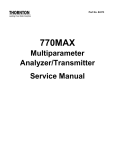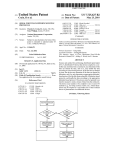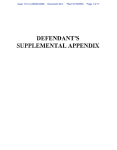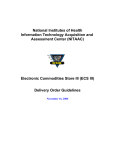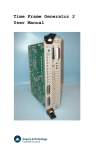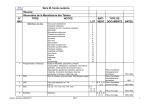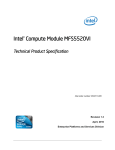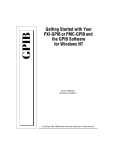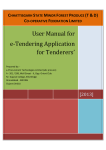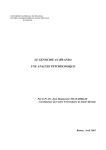Download L0 0-`L
Transcript
US005815690A United States Patent [19] [11] Patent Number: Kowert et al. [45] Date of Patent: [54] 5,815,690 Sep. 29, 1998 Iotech Smart Approach to Instrumentation 1993 Catalog, DEGLITCH METHOD AND APPARATUS TO ASSURE VALID DATA SAMPLING National Instruments Corporation, “Analyzer 488, IEEE Bus Analyzer,” pp. 51—54 and pp. 37—41. [75] Inventors: Robert C. Kowert, P?ugerville; 1993—1994 ICS Electronics Corporation Catalog, “IEEE 488/GPIB Bus Analyzer With Multiline Display,” pp. 7—1—7—6, 4811 Bus Analyzer With Multiline Display, 6 Andrew Thomson, Austin, both of Tex. [73] Assignee: National Instruments Corporation, Austin, Tex. pages (not numbered). GPIB—410 User Manual, Mar. 1994 Edition, Part Number [21] Appl. No.: 916,500 [22] Filed: Aug. 22, 1997 320053—01, National Instruments Corporation, pp. i—xv, 1—1—4—33, A—1—I—1, and Index 1—Index 12. Related US. Application Data [63] Continuation of Ser. No. 472,967, Jun. 7, 1995, abandoned. Primary Examiner—Dennis M. Butler Attorney, Agent, or Firm—Conley, Rose & Tayon; Robert C. KoWert; Jeffrey C. Hood [51] Int. Cl.6 .. [52] U.S. Cl. ................ .. .......................... .. G06F 1/04 [58] Field of Search ................................... .. 395/551, 552, . 395/552; 395/555; 364/574 [57] 395/555, 558; 327/379, 380, 381, 392; A deglitch circuit for ?ltering false transitions of an input signal based on transitions of a clock signal. A plurality of memory devices as provided for detecting the input signal being assay for tWo, three and ?ve transitions of the clock 364/572, 574 [56] ABSTRACT References Cited U.S. PATENT DOCUMENTS signal in the preferred embodiment. Programmable select logic is also provided for selecting between these three cases. In the preferred embodiment, six separate ?ip-?ops 5,014,226 5/1991 Horstmann et al. . 5,018,169 5/1991 Wong et al. . 5,289,060 5,537,379 2/1994 Elnashar et al. . 7/1996 Kimura et al. . 5,649,123 5,649,129 7/1997 Kowert. 7/1997 Kowert. ?ip-?ops being reset upon spurious negations of the input signal for reign such transitions, and Where tWo of the four OTHER PUBLICATIONS ?ip-?ops are clocked on the rising edge Whereas the other tWo are clocked on the falling edge of the clock signal. The National Instruments Corporation Catalog, TNT4882, Single—Chip IEEE 488.2 Talker/Listener ASIC, Jun. 10, programmable select logic preferably includes a multiplexer are included and clocked by the clocked signal, four of the for choosing between the three cases. In the preferred 1994, pp. 1—24. 1994 IEEE 488 and VXIbus Control, Data Acquisition, and Analysis, National Instruments Corporation, “GPIB Moni embodiment, the input signal is the data valid (DAV) signal of a GPIB, Where the deglitch circuit assures valid data sampling on a GPIB. tor/Analyzer, GPIB—410,” 2—126—2—129, High Performance Single—Chip GPIB Talker/Listener ASIC, TNT4882, pp. 20 Claims, 10 Drawing Sheets 2—135—2—136. 700 L 1720 \ 0 o / A 0 724 DAV 722 L0 0-‘L 1 D60 5” D U.S. Patent Sep.29,1998 Sheet 1 0f 10 5,815,690 /102 FIGJ COMPUTER SYSTEM MONITOR II p \124 / MAIN 100 130 / \ MEMORY 122\ 126 110 f GPIB / 11 0 KEYBOARD __ / DEVICE 2 BRIDGE \ LOGIC GPIB 132 106\ , DEVICE 1 ANALYZER/ ; / 104 / CONTROLLER 108 , ‘ ; CARD GPIB 134 110/ DEVICE 3 GPIB DEVICE n / FIG.2 "0 (PRIOR ART) DIOI DIO2 DIO3 DIO5 D106 D107 DIO4 DIO8 EDI REN DAv NRFD NDAC IFC SRO GND GND GND GND GND ATN SHIELD , (TWISTED (TWISTED (TWISTED (TWISTED (TWISTED PAIR PAIR PAIR PAIR PAIR WITH WITH WITH WITH WITH DAv) NRFD) NDAC) IFC) SRO GND (TWISTED PAIR WITH ATN SIGNAL GROUND U.S. Patent Sep.29,1998 Sheet 2 0f 10 5,815,690 F763 106 CAD m4 :02 \ 3°°\ cu< \ 4 .._/-- INTERFACE BUS —C ,,_N\_.. CHIP cM DC 40MHz —-‘CLK “’ 304,‘ DATA .__ FPGA “RFD” ;: NDAC] 306\ GPIB 310/ M __, \ DRIVERS \ \ _ AND GPIB[15=0] RECEIVERS c ‘ W — cm nvr "* 7 ISA 0R PCMCIA 308 FIG.4 CA D GPIB 304 FIFO foo 104 406 402 / DMA 0R0 BUS .4»- INTERFACE | P’ m__ 1.0010 / 400 CD \ FIFO INTERFACE _| LOGIC "FIFO INT \<:> /410 TIME STAMP CAPTURE “Mt-R LOGIC ——"*' \408 DATA 00 108 ' r412 0L - /404 INTERRUPT LOGIC IRQS FRO“ _ OTHER T5555’? 4H’ /414 ACCEPTOR HNSK BLOCKS T0 BUS PINS T0 GPIB PINS U.S. Patent Sep.29,1998 Sheet 5 0f 10 5,815,690 ><Ql.m QQ mNA mnm @U8I3Y0 o mun mNA QQQ I nNA mu6E is @8I3.0 mwkI.-G J. 5,815,690 1 2 DEGLITCH METHOD AND APPARATUS TO ASSURE VALID DATA SAMPLING one device Would be considered a talker and the remaining devices are listen-only devices. A controller is necessary When the active or addressed talker or listener must be changed or recon?gured Where such control functions are CROSS-REFERENCED TO RELATED APPLICATIONS usually handled by a computer device. Also, there may be multiple controllers on a given GPIB, although only one controller is the controller-in-charge (CIC) at any given This application is a continuation of application Ser. No. 08/472,967 ?led on Jun. 7, 1995, noW abandoned. This patent application relates to US. patent application Ser. No. 08/473,110, ?led on Jun. 7, 1995, entitled “GPIB System for Capturing GPIB Signals at a Predetermined Rate and Upon Transitions of the Data Valid Signal”, noW aban doned; US. patent application Ser. No. 08/473,200, ?led on 10 Jun. 7, 1995, entitled “GPIB System Including Real-Time Time-Stamp”, now US. Pat. No. 5,734,876; US. patent application Ser. No. 08/472,626, ?led on Jun. 7, 1995, 15 time. A high speed GPIB handshake protocol referred to as the HS488 is provided to increase the data transfer rate of a GPIB system. The HS488 protocol modi?es the IEEE-488 source and acceptor handshake fuictions to achieve the high speed data transfer rates of up to eight MB/s. Any devices involved in HS488 compliant transfers must be compatible With the HS488 protocol. HoWever, non-HS488 devices may also be coupled to a standard GPIB, Where the HS488 entitled “GPIB System With Improved Parallel Poll devices must use the standard handshake protocol to assure Response Detection” Which issued Jul. 15, 1997 as US. Pat. compatibility. According to the HS488 protocol, the data valid (DAV) signal is asserted and held for a signi?cant period, but the data signals themselves and an end or identify (EOI) control signal may only be valid for a short period of No. 5,649,123; and US. patent application Ser. No. 08/475, 067, ?led on Jun. 7, 1995, entitled “GPIB System Including 20 Controller and Analyzer” Which issued Jul. 15, 1997 as US. Pat. No. 5,649,129. All of the applications are assigned to the same assignee. time, such as approximately 20 ns, relative to the data valid (DAV) signal. A GPIB analyZer is used to monitor a GPIB for testing and FIELD OF THE INVENTION 25 The present invention relates to GPIB instruments, and more particularly to a deglitch circuit for detecting valid GPIB-410 by National Instruments Corporation (National Instruments), Which is used in a similar manner as a logic transitions of the data valid (DAV) signal. DESCRIPTION OF THE RELATED ART 30 for a long period of time, When certain events do occur, such as data transfers according to HS488 protocol, these events occur very quickly and should be sampled and captured functions, including laboratory research, process monitoring 35 RS-232 interface protocol, as Well as data acquisition (DAQ) systems, as knoWn to those skilled in the art. The present invention generally relates to the GPIB and related instruments. The GPIB, otherWise referred to as the Institute of Elec trical and Electronic Engineers IEEE-488 interface bus, Was appropriately. Sampling at a ?xed rate, even if at a very fast rate of 50 nanoseconds (ns), may still miss important events such as data signal changes Which could potentially occur or electrical machinery, to name a feW examples. Aplurality of I/O interface options are available for alloWing commu nication among various instrumentation systems, including the GPIB (general purpose interface bus), the VXI bus, the analyZer to monitor the control and data signals of the GPIB. Prior art GPIB analyZers usually sample data from the GPIB at a ?xed rate. Although activity may not occur on a GPIB Scientists and engineers often use laboratory and indus trial instrumentation systems to perform a variety of and control, data logging, analytical chemistry, tests and analysis of physical phenomena and control of mechanical debugging purposes, Where the analyZer captures data from the GPIB for display and analysis. One such example is the betWeen 50 ns samples. This is particularly true on a GPIB also including HS488 compliant devices, Where data trans 40 fers occur very quickly When compared to standard GPIB data transfer protocols. For example, 50 ns samples Would detect changes of the DAV signal, but could potentially miss changes of the data and E01 signals since these signals 45 remain valid for only a very short time period. Most prior art GPIB analyZers connect to a GPIB system as a separate GPIB device. Thus, if a GPIB system contains the normal limit of 14 devices, a device Would have to be removed to add a prior art GPIB analyZer to the GPIB designed for remote control of programmable instruments. Thousands of measurement instruments from hundreds of suppliers are available With a GPIB interface. GPIB instru ments are typically more sophisticated and have higher system. Also, prior art GPIB analyZers are either stand-alone products containing a poWer supply and vieWing screen, or performance than other interface options, including DAQ an expansion or circuit card designed to plug into a standard and RS-232 boards. Aplurality of instruments, usually up to 14, are coupled through a GPIB using eight-bit parallel computer I/O bus, such as the industry standard architecture (ISA) bus. The prior art GPIB analyZer circuit card type protocol to achieve data transfer rates of over one megabyte per second (MB/s). The GPIB devices can be listeners, talkers and/or controllers. A talker sends data messages to 55 further requires an additional I/ O slot to any GPIB controller card Which may be installed in the same computer. It is further noted that it is often desired to determine the one or more listeners, Which receive the data The controller actual or “real” time that particular information or data Was manages the How of information on the GPIB by sending commands to all devices. Some devices may perform sev captured from the GPIB. Logic analyZers, for example, often attach a time-stamp value to a particular piece of data eral functions, such as a digital voltmeter Which acts as a 60 captured from a group of signals or a bus. The logic analyZer talker by sending voltage information on the GPIB and as a includes a simple counter that may rollover or time-out listener When receiving con?guration and control informa several times, so that the time-stamp value does not indicate tion. Usually, there is only one controller for a given GPIB Where multiple GPIB devices are further coupled to the GPIB for receiving command information from the control ler for interfacing the other GPIB devices. It is noted that some GPIB con?gurations do not require a controller if only rollovers occur. A real-time time-stamp requires a signi? cantly large number of counters to indicate elapsed time With a desired degree of accuracy and time increment resolution. real time betWeen capture events if one or more of such 65 OtherWise, the counter circuitry rolls over and the user may 5,815,690 3 4 not be aware of such rollover. This leads to inaccurate or exhibit false transitions. Aunique data valid deglitch circuit detects such glitches of the DAV signal and thereby sepa otherwise misleading results. Prior art GPIB controllers and/or analyzers may obtain the rates valid from invalid DAV transitions. This assures that status of multiple devices using the parallel poll conmand. valid data is captured into the buffer. The deglitch circuit is Up to eight different devices can be con?gured to respond to preferably programmable for ?ltering false transitions of the the parallel poll command by assigning one of the eight DAV signal based on a clock signal. The deglitch circuit preferably includes a ?rst memory circuit for detecting the DAV signal remaining asserted for at least tWo consecutive GPIB data lines to each device. When the command is issued, each device asserts its assigned data line to indicate that the device is present on the GPMB and requesting service. The GPIB data byte is then retrieved for determin transitions of a clock signal and a second memory circuit for 10 ing the status of the con?gured devices, Where each data signal represents a one bit status. Prior art GPIB analyZers often yield inaccurate results because of the Way the data is sampled during parallel polling. The response of the devices may be delayed and there is no de?ned hold time for a device 15 to hold its response valid. Some prior art analyZers retrieve data at a ?xed rate, so that the data could be retrieved before all of the devices have had a chance to respond or after one or more of the devices have responded and have already negated their responses by the time the data is sampled, thereby resulting in invalid or missed responses. Some devices update their poll status bit during the parallel poll command, thus such updates may be missed by a ?xed rate sampling device. Some analyZers retrieve data both at the beginning and end of the parallel poll command. HoWever, valid responses occurring during the command may still be missed. Still other analyZers sample only at the end of the parallel poll 25 conditions. Each of the memory circuits preferably com prises a set of ?ip-?ops. A time-stamp timer may be enabled to provide a real-time time-stamp value for each set of data captured into the buffer. If enabled, the capture logic asserts a time-stamp select signal to the select logic and enables the buffer for inserting the time-stamp value into the buffer after each capture. In this manner, all of the important transitions occurring on the GPIB are captered into the FIFO along With a real-time time-stamp value identifyng When each capture occurred. The timer includes a counter Which provides a relative resets the counter after each capture. In the preferred embodiment, the timer is a 16-bit counter incremented every 50 ns, Which does not rollover until after approximately 3.28 milliseconds Upon such rollover, the counter asserts a improved performance for capturing all important events time-out signal to the capture logic, Which correspondingly occurring on a GPIB as Well as for time-stamping the 35 enables the maximum timer value of FFFFh (a loWer-case “h” indicating hexadecimal) to be Written into the buffer. The FIFO is preferably a 2K by 18 bit buffer including tWo extra bits for each 16-bit data value. One of the extra bits is SUMMARY OF THE INVENTION A GPIB system according to the present invention includes a GPIB controller and a GPIB analyZer on the same circuit card. The combined controller and analyZer functions require a single connection to the GPIB and a single I/O slot in a host computer. transitions of the clock circuit The user can program the memory circuit to select betWeen any one of these three elapsed time betWeen captures, Where the capture logic command, thus valid responses or updated responses may be completely missed. It is desired to handle all of these cases and retrieve valid and updated responses. In sum, it is desired to provide a GPIB analyZer With captured events in real-time. It is also desired to provide a GPIB analyZer that does not require additional computer or GPIB resources to those required by an existing GPIB controller. detecting the DAV signal remaining asserted for three con secutive clock transitions. A programmable memory circuit selects betWeen the ?rst and second memory circuits. Also, the deglitch circuit can include further memory circuitry for detecting the DAV signal asserted for ?ve consecutive 45 The GPIB system includes sampling logic for sampling the GPIB synchronously or at a predetermined rate, as Well as for sampling the GPIB asynchronously, or according to preferably set for the ?rst rollover or time-out value, thereby marking the ?rst time the timer times out. An interrupt is generated When this buffer location is read to alert the softWare to count remaining time-out values in order to compute the total elapsed time betWeen true data values captured from the GPIB. The softWare easily calculates the real time betWeen each of the true capture data values by summing any time-out values multiplied by 3.28 ms, as Well as by multiplying other time-stamp values by 50 ns. In this manner, a real-time timer marks all signi?cant events on the GPIB With a relatively high resolution, Which changes of the DAV signal. This technique alloWs data to be captured at a regular interval as Well as on edge transitions is preferably achieved using a single 16-bit counter clocked of the DAV signal. The synchronous logic samples data once every 50 ns. For edge transition capturing, the DAV signal every 50 ns. It is noted that since time-out occurs only once every 3.28 ms during long periods of inactivity, the softWare is easily able to keep up With the FIFO, thereby preventing itself is used as the sampling event to clock a set of ?ip-?ops to assure that valid data is not missed by the synchronous logic. Data valid logic detects valid transitions of the DAV signal and provides a data transition select signal to select logic, Which sWitches betWeen the synchronous GPIB over?oW of the FIFO. In an alternative embodiment, each 55 time-stamp value captured into the FIFO is compared With samples are provided to and stored in a buffer, such as a ?rst the maximum value (FFFFh) so that the marking and interrupt method need not be used. This embodiment is preferred for certain applications Which have a signi?cant amount of overhead associated With interrupts. In either in, ?rst out (FIFO) buffer. Capture logic monitors the sampled GPIB signals and the data transition select signal calculated and provided to the user. samples and the asynchronous GPIB samples. The selected and enables the buffer to capture the selected sample upon predetermined capture conditions. In this manner, the cor rect data is detected and captured into the buffer even during fast data transitions. Sampling data from the GPIB based on the DAV signal could result in erroneous data since the DAV signal tends to embodiment, elapsed time betWeen capture events is easily A GPIB system according to the present invention retrieves all valid and updated responses to a parallel poll command. The GPIB data is captured immediately after a 65 parallel poll command is issued as Well as after the com mand is deasserted. Also, a timing device causes another sample to be captured after approximately 2 microseconds 5,815,690 5 6 (,us) to give the devices time to provide a valid response. Furthermore, more samples are captured during any data line transitions that occur While the plel poll command remains asserted. This assures that any initial and updated responses are captured during the command, Which Would otherWise be missed in prior art embodiments. Therefore, a GPIB system according to the present inven tion captures important events occurring on the GPIB into a input/output (I/O) or expansion bus 104 Which is preferably based on the industry standard architecture (ISA) also referred to as the AT bus. It is noted that the computer 102 may be any one of several knoWn types such as the Apple Computer or Macintosh or may include any one of several Work stations such as the Sun SPARCstation, etc. The buffer in an accurate manner. Also, a timer provides a real-time time-stamp value, Which is inserted into the buffer folloWing each associated captured value if desired. The real-time time-stamp has a high resolution and provides an accurate temporal determination of each captured value. Furthermore, both controller and analyZer functions are included for conserving computer resources. 10 expansion bus 104 could alternatively be based on the Extended ISA (EISA), the PCMCIA standard or the PCI (peripheral component interconnect) bus or any one of the knoWn I/O or expansion buses of computer systems. A GPIB analyZer/controller card 106 plugs into one of the I/O slots of the computer 102 for connecting to the expan sion bus 104 of the computer 102. The GPIB analyZer/ controller card 106 couples the computer 102 to a GPIB 108, A better understanding of the present invention can be also knoWn as the IEEE 488 interface bus. At least one and normally a plurality of GPIB devices 110 are further con nected to the GPIB 108 in any one of several knoWn methods, such as series or star con?gurations, etc. Each of the GPIB devices 110 may be any one of thousands of obtained When the folloWing detailed description of the preferred embodiment is considered in conjunction With the manner, the computer 102, through the GPIB analyZer/ 15 BRIEF DESCRIPTION OF THE DRAWINGS adapted for commnunicating on the GPIB 108. In this folloWing draWings, in Which: controller card 106, controls all of the GPIB devices 110 on the GPIB 108. Each of the GPIB devices 110 can be listeners, talkers and/or controllers as knoWn to those skilled FIG. 1 is a simpli?ed block diagram illustrating a GPMB system including a GPIB analyZer according to the present invention; 25 FIG. 2 is a diagram illustrating the standard GPIB signals; FIG. 3 is a simpli?ed block diagram of a GPIB system according to the present invention including analyZer and controller functions; FIG. 4 is a simpli?ed block diagram of the GPIB analyZer portion of the GPIB system of FIG. 3; FIG. 5 is a schematic diagram illustrating the logic for capturing GPIB control signals; FIG. 6A is a schematic diagram illustrating logic for capturing the data signals of the GPIB; FIG. 6B is a schematic diagram illustrating logic for capturing the end or identify control signal of the GPIB; 35 The computer 102 may include bridge logic 120, for coupling the expansion bus 104 to a system (or local) bus 122, although other con?gurations are contemplated. The computer 102 further includes a microprocessor 124, such as an 80386, i486 or Pentium processor by Intel, and main memory 126 coupled to the system bus 122. Of course, the computer 102 also typically includes a monitor 130 and FIG. 7A is a schematic diagram of the logic for identify ing the assertion of the DAV signal of the GPIB; associated graphics controller (not shoWn) as Well as input devices such as a keyboard 132 and mouse 134. In this manner, the user loads softWare routines into main memory FIG. 7B is a schematic diagram of the deglitch circuit of FIG. 7A; FIGS. 7C and 7D are timing diagrams illustrating opera tion of the deglitch circuit of FIGS. 7A and 7B; in the art. In the preferred embodiment, the GPIB analyZ erlcontroller card 106 includes the primary controller of the GPIB 108 for controlling each of the GPIB devices 110. As Will be described more fully beloW, the GPIB analyZer/ controller card 106 further includes the GPIB analyZer for monitoring signals on the GPIB 108 for testing and debug ging purposes by capturing data or control signals from the GPIB 108 for display and analysis. 126 (from data drives, etc.) for execution by the micropro cessor 124 for sending and receiving data and commands for 45 FIG. 8 is a schematic diagram of the time-stamp timer of programming and controlling the GPIB analyZer/controller card 106, and for ultimately controlling or otherWise moni toring the GPIB 108 and associated GPIB devices 110. FIG. 4; FIG. 9 is a schematic diagram illustrating logic for Referring noW to FIG. 2, a diagram is shoWn of a GPIB connector With standard signal assignment as knoWn to those skilled in the arts Pin numbers 1—4 and 13—16 com performing parallel poll; FIGS. 10A and 10B are simpli?ed logic diagrams illus trating logic for identifying predetermined capture condi prise the eight-bit data bus of the GPIB 108, including data tions of the control and data signals, respectively; FIG. 11 is a schematic diagram of the logic for identifying bus signals D101—D108, otherWise referred to as the DIO all capture conditions on the GPIB; FIGS. 12A and 12B illustrate a capture logic state signals. The connector 200 includes three handshake signals for asynchronously controlling the transfer of message bytes 55 betWeen the GPIB devices 110 for guaranteeing that data is sent and received Without transmission error. The handshake machine and its operation; and FIG. 13 is a schematic diagram of the multiplexer logic lines include a not ready for data (NRFD) signal Which for capturing data into a FIFO buffer. message byte. The NRFD signal is driven by any device indicates When a device is ready or not ready to receive a receiving commands, by listeners When receiving data DETAILED DESCRIPTION OF THE PREFERRED EMBODIMENT messages, and by a talker When enabling the HS488 mode. A not data accepted (NDAC) signal indicates When a device has or has not accepted a message byte. The NDAC signal is driven by any of the GPIB devices 110 When receiving Referring noW to FIG. 1, a simpli?ed block diagram is shoWn of a GPIB system 100 including a GPIB analyZer and controller card 106 implemented according to the present invention. A computer 102, Which is preferably a personal computer (PC) such as the XI or AT by IBM, includes an 65 commands and by listeners When receiving data messages. A data valid (DAV) signal indicates When the DIO signals are stable and valid and thus can be accepted safely by any 5,815,690 7 8 of the GPIB devices 110. The GPIB analyZer/controller card 106 drives the DAV signal When sending commands, and a talker drives the DAV signal When sending data messages. The GPIB 108 further includes ?ve interface management signals for managing the How of information across the Referring noW to FIG. 4, a block diagram is shoWn of the FPGA 304 coupled to the eXpansion bus 104, to the GPIB 108, and to the FIFO 300. Bus interface logic 400. decodes register accesses to the other functional blocks Within the FPGA 304 and couples to the DMA logic 402 and the GPIB 108. An attention (ATN) signal is driven by the GPIB analyZer/controller card 106 When using the DIO data sig interrupt logic 404 to generate DMA and interrupt requests. The DMA logic 402 is connected to a FIFO interface 406 in order to detect When data is present in the FIFO 300 so that DMA may be requested to unload data from the FIFO 300. nals to send commands, and otherWise drives the ATN signal loW to alloW a talker to send data messages. An interface clear (IFC) signal is driven by a controller to initialiZe the The FIFO interface 406 provides the control signals to read GPIB 108 and to establish that controller as the controller data from or Write data to the FIFO 300. in-charge (CIC). A remote enable (REN) signal is driven by The primary function of the FPGA 304 is to capture the state of the control and data signals of the GPIB 108 based on certain programmed conditions. The control and data signals of the GPIB 108 are all sampled every 50 ns by capture logic 410. Also the DIO and EOI signals are sampled upon assertion edge transitions of the DAV signal. This the controller to place the devices in remote or local program mode. A service request (SRQ) signal is driven by any one of the GPIB devices 110 to asynchronously request service from the GPIB analyZer/controller card 106. Finally, an end or identify (EOI) signal is used by a talker to mark the end of a message string and is alternatively used by the controller 15 asynchronous sample of the DIO and EOI signals is desired because they might otherWise be missed at the 50 ns ?Xed if HS488 transfers are used. If a programed capture condition to tell the GPIB devices 110 to identify their response in a parallel poll command. Referring noW to FIG. 3, a block diagram is shoWn of the is true, the sample retrieved by the capture logic 410 is GPIB analyZer/controller card 106 implemented according provided through the FIFO interface 406 to the FIFO 300. If the capture condition is not true, the sample retrieved from the GPIB 108 is discarded. A capture enable signal referred to the present invention. The eXpansion bus 104 includes control (C), address (A), and data (D) signals connected to the primary controller portion referred to as the TNT 308, Which is preferably the TNT4882C ASIC by National Instru to as CAPiEN determines Whether capturing is enabled or 25 ments but may be any GPIB controller circuit such as the NEC 7210. The TNT 308 is further connected to the data (D) and control (C) signals of the GPIB 108. The TNT 308 preferably performs the basic IEEE 488 talker, listener, and control functions required by the ANSI/IEEE 488.2 standard (ANSI is the American National Standard Institute). In the preferred embodiment using the ISA expansion bus, the handshake line transitions by monitoring state changes of the NDAC, NRFD and DAV signals; upon control line trnitions by monitoring the IFC, REN, ATN and SRO signals TNT 308 preferably can sustain data transfers up to 1.5 MB/s using the IEEE 488.1 standard three-Wire handshake. The TNT 308 also preferably implements the high speed 35 an ISA platform or 3.4 MB/s on a computer system incor porating the EISAplatform. It is noted that for embodiments using different expansion buses, the TNT data transfer rates 800 (FIG. 8) preferably clocked by the CLK50 signal for a may vary. The TNT 308 is also used to monitor the GPIB 108 as Well as to provide device emulation, source resolution of 50 ns per bit. Of course, other frequencies and resolutions are contemplated and are a matter of design choice. The tinier 408 is used to determine the amount of time betWeen capture events of the GPIB 108 through the handshaking, and pattern generation. Preferably, a bus interface chip 310 provides a chip select to the TNT 308 and to the primary analyZer portion, referred capture logic 410. Thus, Whenever time-starting is enabled, 45 Semiconductor that conforms to the ISA Plug and Play speci?cation is used. The bus interface chip 310 preferably interfaces DMA (direct memory access) channels and inter rupt request signals (IRQ) to the eXpansion bus 104. The FPGA 304 controls the capturing of the status of the GPIB 108 into a high speed 2K by 18 bit FIFO 300. Through the FPGA 304, the GPIB analyZer/controller card 106 can be con?gured to capture and/or trigger on any transition or state of interest on the GPIB 108. The captured status is then read for any state changes; upon command tranfer When both the ATN and DAV signals are true; upon data transfer When ATN is false and DAV is true; upon data line tranitions; upon time-stamp timer rollover of a time-stamp timer 408; and When a Force Capture Pulse Command is through softWare. The time-stamp timer 408 includes a 16-bit counter circuit GPIB protocol (HS488) for data transfers up to 1.6 MB/s on to as the FPGA 304. In the preferred embodiment, a bus interface chip such as the NM95MS15P from National disabled. If the CAPiEN signal is true and the FIFO 300 is not full, capturing Will take place according to one of several capture conditions as folloWs: When a trigger condition is true; upon the occurrence of a parallel poll When a signal IDY is true, Where IDY=ATN & EOI (FIG. 9); upon 55 from the FIFO 300 by the computer system 102 for analysis and display on the monitor 130, if desired. An oscillator 302 provides a 40 MHZ clock signal (CLK) to the FIFO 300, the FPGA 304, and the TNT 308. The CLK signal is used to develop tWo clock signals internal to the FPGA 304, one a time-stamp value is Written into the neXt location of the FIFO 300 after a sample is captured into the FIFO 300 from the capture logic 410, as described more ?lly beloW. In this manner, the FIFO 300 contains GPIB samples and time stamp values in alternating locations. Trigger logic 412 coupled to the GPIB 108, the bus interface logic 400 and the capture logic 410 alloWs the FPGA 304 to trigger on any predetermined pattern of signals appearing on the GPIB 108. The trigger pattern is speci?ed and con?gured by a trigger and pattern register (TRPR) and a trigger mask register (TRMR). Setting a bit in the TRMR register indicates that trigger logic 412 Will treat the corre sponding signal on the GPIB 108 as a don’t care. For each bit that is not set Within the TRMR register, the trigger state of the signals of GPIB 108 are determined by the state of the corresponding TRPR register bits. Thus, a trigger condition having a 25 ns period referred to as CLK25 and another having a 50 ns period referred to as CLK50. Also, GPIB occurs When a sample of the GPIB 108 equals the pattern drivers and receivers 306 provide interfacing of the FPGA turing is enabled and if triggering bits are set, the current GPIB sample is captured into the FIFO 300 each time the trigger condition tranitions from false to true or alternatively, only the ?rst time the trigger condition tranitions from false 304 to the GPIB 108, Where the GPIB drivers and receivers 306 are used by the FPGA 304 to independently assert the control signals of the GPIB 108 for the acceptor handshake and to receive the signals of the GPIB 108 for capturing. speci?ed by the TRMR and TRPR registers. Thus, if cap 65 to true. 5,815,690 9 10 Finally, the FPGA 304 is con?gured to participate in the signals of the GPIB 108 are sampled at 50 ns intervals in a similar manner as the control signals of the GPIB 108 GPIB handshake as an acceptor through acceptor handshake logic 414. Participation in the handshake is enabled by setting an HNSKiEN enable bit in a handshake con?gu described above in FIG. 5, except that a single signal CAPiDAT identi?es any changes of state of the DIO data ration register. Also, the acceptor handshake logic 414 may signals. be programmed to vary the rate of the GPIB acceptor handshake. Referring noW to FIG. 5, a schematic diagram is shoWn of The DIO(0) signals are also provided to the respective D inputs of a set of eight D-type ?ip-?ops 606, each receiving the DAV signal at their respective clock inputs. In this the logic for sampling and comparing the control signals of manner, each of the DIO signals appearing on the GPIB 108 are sampled With each assertion of the DAV signal by the the GPIB 108. In particular, all of the control signals except the EOI and DAV signals, including the IFC, REN, SRQ, ATN, NRFD and NDAC signals, are collectively referred to 10 ?ip-?ops 606, Which provide signals DAViDIO(1) at their respective Q outputs. The DAViDIO(1) signals are pro as GPIBiCTL(0) as appearing at a time t=0 relative to the CLK50 signal on the GPIB 108. The GPIBiCTL(t) desig nation represents individual signals IFC(t), REN(t), SRQ(t), 15 vided to the respective D inputs of a set of eight D-type ?ip-?ops 608 receiving the CLK50 clock signal at their respective clock inputs. The ?ip-?ops 608 provide a set of ATN(t), etc. The EOI signal is handled in a similar manner as the DIO signals, as described beloW. The DAV signal is handled in a different Way Which is described beloW. The signals DAViDIO(2) signals at their Q outputs. In this manner, the DIO(t) signals generally represent samples of GPIBiCTL(0) signals are each provided to the D inputs of a set of six D-type ?ip-?ops, collectively referred to by the reference number 500. Only one ?ip-?op 500 is shoWn, it being understood that it is repeated six times for each of the Whereas the DAViDIO(t) signals represent the data signals control signals of the GPIB 108. It is noted that any appropriate type of latch or ?ip-?op may be used to sample signals of the GPIB 108, Where D-type ?ip-?ops are used in the illustrated embodiment. The CLK50 signal is provided to are captured by the ?ip?ops 606. the data signals on the GPIB 108 at a ?xed interval of 50 ns, of the GPIB 108 When the DAV signal is asserted. In this manner, very fast changes of the DIO data signals, Which might otherWise be missed by a ?xed rate capture of 50 ns Refering noW to FIG. 6B, a schematic diagram is shoWn 25 108, Which is similar to the logic for capturing the DIO data signals. The EOI signal is provided to the D inputs of tWo D-type ?ip-?ops 610 and 616. The ?ip-?op 610 receives the CLK50 signal at its clock input and provides a itched EOI(1) signal at its Q output. The EOI(1) signal is provided to another D ?ip-?op 612, Which is also clocked by the CLK50 signal for providing a signal EOI(2) at its Q output The the clock input of the ?ip-?ops 500 for sampling the control signals of the GPIB 108 every 50 ns, Where the initial sampled versions are referred to as signals GPIBiCTL(l) at the outputs of the ?ip-?ops 500. This process is repeated again Where the GPIBiCTL(l) signals are provided to the D inputs of another set of six D-type ?ip-?ops 502, Which receive the CLK50 signal at their clock inputs. The ?ip-?ops 502 provide signals GPIBiCTL(2) at their Q outputs, representing latched versions of the GPIBiCTL(l) signals EOI(1) and EOI(2) signals are provided to the respective tWo inputs of a tWo-input XOR gate 614, Which provides a 35 after 50 ns. Each of the GPIBiCTL(2) signals are provided to one signal CAPiEOI at its output indicating changes of the EOI signal. The ?ip-?op 616 is clocked by the DAV signal for sampling the EOI signal upon assertions of the DAV signal, Where this sampled value is provided as a signal DAYiEOI input of a set of six, tWo-input exclusive-OR (XOR) gates 504, Where the GPIBCTL(1) signals are provided to the (1) at the Q output of the ?ip-?op 616. The DAViEOI(1) signal is provided to the D input of another D ?ip-?op 618, Which is clocked by the CLK50 signal for providing a signal DAViEOI(2) at its Q output In this manner, changes of the EOI signal are sampled along With the DIO signals upon other input of each of the XOR gates 504. In this manner, the XOR gates 504 provide a set of CAPiCTLN signals rep resenting change of state of the control signals of the GPIB 108 betWeen successive clock cycles of the CLK50 clock signal, for detecting certain capture conditions as described beloW. The subscript “n” represents multiple signals, Where CAPiCTL, generally represents all of the signals CAPi IFC, CAPiREN, CAPiSQR, CAPiATN, CAPiRFD and CAPiDAC denoting changes of the IFC, REN, SQR, ATN, NRFD and NDAC signals, respectively. illustrating logic for capturing the EOI signal of the GPIB assertion transitions of the DAV signal. 45 Referring noW to FIG. 7A, a schematic diagram is shoWn illustrating the logic for detecting transitions of the DAV signal on the GPIB 108. The DAV signal is provided to a deglitch circuit 700, Which provides a signal SDAV at its output. It is noted that spurious assertions of the DAV signal Referring noW to FIG. 6A, a schematic diagram is shoWn could cause erroneous collection of data Which is not desired for sampling and detecting changes of the DIO signals on the by the user. Such erroneous data may be sampled by the ?ip-?ops 606, but are not captured as described before. The GPIB 108. The DIO signals, collectively referred to as DIO(0), are provided to the D inputs of a set of eight D-type ?ip-?ops 600, receiving the CLKSO signal at their respective clock inputs. The Q outputs of the ?ip-?ops 600 provide deglitch circuit 700 generally detects the spurious assertions of the DAV signal providing a ?ltered version as the SDAV 55 signal. The SDAV signal is provided to the D input of a D-type ?ip-?op 704, receiving the CLK25 clock signal at its clock-input, Where the SDAV signal and the Q output of the signals DIO(1), Which are latched versions of the DIO(0) signals. The DIO(1) signals are provided to the D inputs of another set of eight D-type ?ip-?ops 602, each receiving the CLK50 signal at their respective clock inputs. The Q outputs ?ip-?op 704 are both provided to the tWo inputs of an OR gate 706 for providing its output to the binary 0 input of a of the ?ip-?ops 602 provide latched signals DIO(2) Which multiplexer (mux) 708. The DAV signal is also provided to are each provided to one input of a set of eight tWo-input the binary 1 input of the mux 708, Which receives an override signal OS at its select input The output of the mux 708 re?ects the selected binary input based on the state of the select signal provided to the mux 708. A signal DGO is provided to the non-inverted input of a tWo input AND gate 718, Which asserts the OS signal at its XOR gates 604. The DIO(1) signals are provided to the other respective inputs of the XOR gates 604, Which provide a set of eight CAP-DATE signals to the respective inputs of an eight input OR gate 605, Which asserts a signal CAPiDAT at its output. Thus, the CAPiDAT signal is asserted When any of the DIO signals change state. In this manner, the data 65 output Another signal DGI is provided to the inverting input 5,815,690 11 12 of the AND gate 718. As described below, the DGO and DG1 signals set timing parameters Within the deglitch circuit 700. The OS signal is asserted When deglitching is turned off and the deglitch circuit 700 is effectively bypassed. The output TABLE 1 Programming values for the DAV Deglitch Circuit of the mux 708 is provided to the D input of a D-type ?ip-?op 710, receiving the CLK50 signal at its clock input. DG1, DGO The Q output of the ?ip-?op 710, referred to as a signal 00 12.5 SDAV1, is provided to the D input of a D-type ?ip-?op 712 receiving the CLK50 signal at its clock input. The Q output of the ?ip-?op 712 is a signal SDAV2, Which is provided to the inverting input of a tWo-input AND gate 714, Which receives the SDAV1 signal at its non-inverting input and Which provides the CAPiDAViASSRT signal at its output. The SDAV1 signal is provided to the inverted input of another tWo-input AND gate 716, Which receives the SDAV2 signal at its non-inverting input for providing the 01 not used — OS asserted 1O 11 Max Pulse Rejected (ns) 25 5O Min Pulse Recognized (ns) 25 not used — OS asserted 37.5 75 10 15 CAPiDAViUNASRT signal. Operation of the circuit shoWn in FIG. 7A is noW described. It is noted that the DAV signal valid transitions are normally held long enough for capture by a 50 ns ?xed rate sampling period. HoWever, it is desired not to capture sampled data in the event the DAV signal transition Was spurious and not associated With a valid data change. Any Where the maximum pulse rejected indicates that the deg litch circuit 700 Will reject any pulse less than the indicated duration and the minimum pulse recogniZed indicates that the deglitch circuit 700 is guaranteed to recogniZe a pulse greater than the indicated duration. For clarity, the output signals of the ?ip-?ops 720,726, 724, 722, 730 and 732 are shoWn as signals A, B, C, D, E and F, respectively, although signals E and F are referred to as tWo separate signals, E0, E1 and F0, F1, respectively, in timing diagrams (FIGS. 7C, 7D) depending upon the state of the DGO signal. The general operation of the deglitch circuit 700 is noW described. The maximum rejected and minimum recogniZed pulse times are based on transitions of the CLK25 signal. valid assertions of the DAV signal on the GPIB 108 as For the DG1, 0=00 case, a DAV pulse must remain asserted detected by the deglitch circuit 700 are asserted as the SDAV 25 during at least tWo consecutive transitions of the CLK25 signal for at least 25 ns. The OR gate 706 detects any signal, Which means for more than 12.5 ns, to be detected by assertions or deassertions of the DAV signal. When OS is the ?ip-?op 740. Pulses less than to 12.5 ns do not meet this loW, such assertions or deassertions are captured by the ?ip-?op 710, Which are provided to the ?ip-?op 712 and also to the AND gate 714. Thus, the output of the AND gate 714 asserts the CAPiDAViASSRT signal When the DAV sig nal is asserted from loW to high during any 50 ns clock cycle. Deassertions or negations of the DAV signal are detected by criterion and are rejected. It is noted that pulses exactly equal to 12.5, 25, 37.5 ns etc. having edges concurrent With the CLK25 transitions may or may not meet the tiring parameters and are a matter of probability. Such exact cases are considered trivial and Will be ignored for purposes of this disclosure. For the DGI, 0=00 case, the A signal is asserted the AND gate 716 as the CAPiDAViUNASRT signal in a similar manner. by the ?ip-?op 720 Whenever the DAV signal is true on a 35 rising edge of the CLK25 signal, but is only asserted While Referring noW to FIG. 7B, a schematic diagram is shoWn DAV is true. If DAV is true for at least 12.5 ns, then the of the deglitch circuit 700. The DAV signal is provided to the ?ip-?op 724 asserts the C signal. Since the ?ip-?op 724 remains asserted for a full clock cycle, the ?ip-?op 740 asynchronous clear inputs of four D-type ?ip-?ops 720, 722, 726 and 730. The ?ip-?ops 720, 722, 726 and 730 receive the CLK25 signal at their clock inputs, although the ?ip ?ops 722 and 726 invert the CLK25 signal and thus are clocked on the falling edges. The D inputs of ?ip-?ops 720, 722 are ?xed at a high logic level. The Q output of ?ip-?op 720 is provided to the D input of ?ip-?op 726, to the D input of another ?ip-?op 724 and to the binary 1 input bit of a tWo-input mux 727. The ?ip-?op 724 receives the CLK25 signal at its inverted clock input The Q output of ?ip-?op 722 is to the binary 0 input of the mux 728, Which receives the DGO signal at its select input. The output of mux 728 is provided to the D input of the ?ip-?op 730, Which provides its output to the D input of another ?ip-?op 732 receiving the CLK25 signal at its inverted clock input The Q output of the ?ip-?op 732 is provided to one input of a tWo-input OR gate 734, Which receives the Q output of the ?ip-?op 726. The output of the OR gate 734 is provided to the binary 10 input detects Whether the DAV signal is asserted on a rising edge and lasts at least until the folloWing falling edge of the CLK25 signal. The ?ip-?op 722 asserts the D signal When DAV is true on a falling edge of the CLK25 signal, but only for so long as DAV remains true. If DAV remains true for at 45 encompass tWo consecutive transitions of CLK25 are detected. In a similar manner, a DAV pulse must remain asserted for three consecutive transitions of the CLK25 signal (25 ns) to be detected When DG1, 0=10. In this case, the B signal is asserted if the DAV pulse is true on a rising edge and lasts 55 of a three-input mux 738, Which receives the DG1, DGO signals at its tWo select inputs and provides its output to the at least until the folloWing falling edge. HoWever, the ?ip-?op 740 only detects the assertion of the B signal if the DAV pulse remains asserted until the folloWing rising edge, D input of a D-type ?ip-?op 740. The ?ip-?op 740 receives the CLK25 signal at its clock input and provides the SDAV signal at its output. The Q outputs of the ?ip-?ops 722, 724 are provided to the respective inputs of a tWo-input OR gate 736, Which provides its output to the binary 00 input of the since otherWise the ?ip-?op 726 is cleared Also, the F signal is asserted by the ?ip-?op 732 only if the DAV pulse is true on a falling edge as detected by the ?ip-?op 722, and if the pulse remains true until the next falling edge, since other Wise the ?ip-?ops 722 and 730 are cleared. Thus, the DAV pulse must be true for three consecutive transitions of the mux 738. The Q output of the ?ip-?op 730 is connected to the binary 11 input of the mux 738. The deglitch circuit 700 is programmed using the DGO and DG1 signals to provide recognition according to the folloWing table 1: least 12.5 ns until the folloWing rising edge of the CLK25 signal, then the ?ip-?op 740 detects this pulse. In this manner, any pulse greater than 25 ns is guaranteed to be detected by the ?ip-?op 740, pulses less than 12.5 ns Will alWays be rejected and those betWeen 12.5 and 25 ns that 65 CLK25 signal. Thus, pulses greater than 37.5 ns are alWays detected While pulses less than 25 ns are alWays rejected. Pulses betWeen 25 and 37.5 ns are only detected as long as they encompass three consecutive CLK25 transitions. 5,815,690 14 13 one input of the AND gate 804 for starting the counter circuit For the DG1, 0=11 case, a DAV pulse must remain asserted for three consecutive rising edges of the CLK 25 800 if enabled and not in a reset state. The CAPiEN signal signal (50 ns). The ?rst and second rising edges are detected by the ?ip-?ops 720 and 730, respectively, Which are cleared unless the pulse remains asserted until the following rising edge of the CLK25, Where the E signal is latched by the is provided to the inverted reset input of the ?ip-?op 802 for keeping the counter circuit 800 in the reset state if the CAPiEN signal is deasserted When capture is not enabled. The AND gate 804 receives the TSiEN signal, Which is asserted to enable time-stamping. The AND gate 804 also ?ip-?op 740. Thus, pulses equal to or less than 50 ns are alWays rejected While pulses greater than 75 ns are alWays detected. Again, any pulses having a duration betWeen 50 and 75 ns are detected as long as they remain asserted during 10 three consecutive rising edges. Referring noW to FIG. 7C and 7D, timing diagrams are shoWn illustrating operation of the deglitch circuit 700. In FIG. 7C, the CLK25 signal is provided at the top and ten pulses are shoWn asserted on the DAV signal, Where pulses 1 and 2 have durations greater than 6 but less than 12.5 ns, pulses 3 and 4 have durations greater than 12.5 but less than 25 ns, pulses 5 and 6 have durations greater than 25 but less than 37.5 ns, pulses 7 and 8 have durations greater than 37.5 but less than 50 ns and Where pulses 9 and 10 have durations greater than 50 ns. For purposes of illustration, pulses 3, 5, 15 T[15z0]. The time signals T[15z0] are preferably separated into tWo 8-bit portions, Where the T[1518] signals are referred to as the TIMiHI byte and the T[7:0] signals are referred to as the TIMiLO byte (FIG. 13). S The counter circuit 800 asserts a time-out signal TO indicating rollover. The TO signal could be asserted When 7 and 10 have slightly longer durations than corresponding respective pulses 4, 6, 8 and 9. The output of the muX 738 is shoWn based on the DGO and DG1 signals. In FIG. 7D, the CLK25 and DAV signals are repeated and the SDAV signal is shoWn based on the DGO and DG1 signals for cases 11, receives a signal RSTiTIM*, Which is asserted loW to reset the counter circuit 800, as Will be described more fully beloW. In this manner, the counter circuit 800 remains in a reset state any time capturing or the time-stamp functions are disabled, or any time the RSTiTIM’F signal is asserted, indicating the desire to reset the counter circuit 800. OtherWise, the counter circuit 800 counts up from 0, pro viding a 16-bit time value at its outputs as the signals the counter circuit 800 reaches its maximum value of FFFFh, Where the T[15z0] signals are all 1’s. In the preferred 25 10 and 00, respectively. Inspection of FIG. 7D reveals that pulses 1 and 2, being less than 12.5 ns, are not detected and thus are rejected in all three cases of the DG1, 0 signals. Pulses 3 and 4 are betWeen embodiment, hoWever, the counter circuit 800 counts up to the value FFFDh and asserts the TO signal at FFFDh, Which occurs tWo CLK50 cycles before it reaches its maXimum value of FFFFh Upon the neXt CLK50 cycle, the counter circuit goes to FFFEh and negates the TO signal and tWo ?ip-?ops 1106 and 1108 (FIG. 11) are clocked to assert the corresponding signals NiCAP and CAP. If the NiCAP signal is asserted When the counter circuit 800 reaches FFFEh indicating a normal capture condition has occurred, it stops counting at FFFEh so that the value FFFEh is Written 12.5 and 25 ns, yet only pulse 3 is detected for the DG1, 0=00 case since pulse 3 encompasses tWo consecutive transitions of the CLK25 signal While pulse 4 does not. Both pulses 3 and 4 are rejected by the DG 1, 0=10 and 11 cases. into the FIFO 300 as a normal time-stamp value. This Pulses 5 and 6 are both betWeen 25 and 37.5 ns and thus are 35 distinguishes a normal capture from a rollover condition detected for the DG 1, 0=00 case and yet rejected for the occurring Without a capture. HoWever, if the NiCAP signal DG1, 0=11 case. Since pulse 5 encompasses three consecu detected by both DG1, 0=00, 10 cases, yet rejected by the is not asserted at FFFEh, the counter circuit 800 provides the maXimum value FFFFh at its output, Which is then Written to the FIFO 300 indicating a rollover condition rather than a normal time-stamp value. Time-stamping preferably does not start until the ?rst DG1, 0=11 case. Finally, pulses 9 and 10 are betWeen 50 and 75 ns and detected by both DG1, 0=00, 10 cases, but only pulse 10 is detected by the DG1, 0=11 case since it encom TIM* signal ensures the counter circuit 800 is held in the reset state until after the ?rst capture and is reset upon each tive CLK25 transitions While pulse 6 does not, pulse 5 is accepted and pulse 6 is rejected for the DGI, 0=10 case. Pulses 7 and 8 are both betWeen 37.5 and 50 ns and thus are passes three consecutive CLK25 rising edges, While pulse 9 capture after time-stamping has been enabled. The RSTi 45 capture. Thus, the time-stamp for the ?rst capture is pref does not. Although not shoWn, any pulses greater than 75 ns erably Zero. Since the counter circuit 800 is reset after each are detected by all three cases. capture, each time-stamp value represents the elapsed time Referring noW to FIG. 8, a schematic diagram of the since the previous capture. HoWever, if a capture or trigger time-stamp timer 408 is shoWn. The time-stamp timer 408 condition is not met, the counter circuit 800 reaches its maXimum value of FFFFh in approximately 3.28 ms. In the includes a 16-bit counter circuit 800, preferably including a 16-bit up-counter, Which receives the CLK50 clock signal at a clock input. The counter circuit 800 receives a signal NiCAP, Which is asserted When any capture conditions are true eXcept rollover of the counter circuit 800. The counter circuit 800 includes an inverted reset input receiving a signal preferred embodiment, if the current time-stamp is referred to as X, and the number of time-outs or rollovers since the last capture value is y, then the real time value RT in ns is calculated by the folloWing equation (1): 55 TIMERiRST’E Which is asserted by a three input AND gate 804. An asterisk RT(ns)=50(x+1)+3,276,750(y) at the end of a signal name denotes negative logic, Where the signal is considered asserted When loW and negated When high. Thus, the counter circuit 800 is identify capture conditions according to parallel poll cleared When TIMERiRST’F is asserted loW, so that the counter circuit 800 goes to Zero and begins counting up again When TIMERiRST’F is negated. AD-type ?ip-?op 802 has its D input pulled high to logic one and receives a CAP signal at its clock input The CAP signal, described furter beloW, is asserted When any of several capture conditions are true including rollover of the timer 800. The ?ip-?op 802 asserts a signal STRTiTIM to (1) Referring noW to FIG. 9, a logic diagram is shoWn for 65 responses on the GPIB 108. The EOI(1) and ATN(1) signals are each provided to the inputs of a tWo-input AND gate 900. The EOI(2) and ATN(2) signals are each provided to the inputs of another tWo-input AND gate 902. The outputs of the AND gates 900, 902 are provided to the respective inputs of a tWo-input XOR gate 904. The output of the AND gate 900 is also provided to the active loW reset inputs of a timer 906 and a D-type ?ip-?op 908. The timer 906 is preferably 5,815,690 15 16 a 2 microsecond (us) timer including a simple up-counter clocked by the CLK50 signal. Thus, after 2 us, the timer 906 provides a time-out signal, POLLiTO, Which is asserted When has elapsed since the reset input of the timer 906 Was deasserted. The POLLiTO signal is provided to the D input receives a capture control line transition signal CPiCTL at of the ?ip-?op 908, having its clock input receiving the CLK50 signal. The Q output of the ?ip-?op 908 provides a input OR gate 1004, Which receives the CAPiDAVi UNASRT signal at its third input. The output of the OR gate signal POLLiTO, Which is provided to the inverting input of a tWo-input AND gate 910. The other, non-inverting input Which receives a capture handshake line transition enable of the AND gate 910 receives the POLLiTO signal. The output of the AND gate 910 is provided to one input of a tWo-input OR gate 912, Which receives the output of the XOR gate 904 at its other input. The output of the OR gate 912 provides the CAPiIDY signal, Which indicates appro priate capture conditions according to parallel responses on its other input. The CPiCTL signal is set in a capture setting register (CPSR) for enabling detection of any changes of the IFC, REN, ATN and SRO signals. The CAPiDAC and CAPiRFD signals are provided to tWo inputs of a three 1004 is provided to one input of a tWo-input AND gate 1006, 10 The CAPiIDY signal is provided to one input of a tWo-input AND gate 1008, Which receives a capture on parallel poll response enable signal CPiPPR, Which is set in 15 the GPIB 108. The CPiPPR and QPOLLiTO signals are provided to the respective inputs of a tWo-input AND gate 1010, pro viding its output to one input of a tWo-input OR gate 1012, CLKSO signal, both EOI(1) and ATN(1) are asserted thereby removing the reset condition to the timer 906 and the ?ip-?op 908. Also, since the command Was not issued in the Which receives a capture data enable signal CPiDAT at its other input The CPiDAT bit is set in the CPSR register. The output of the OR gate 1012 is provided to one input of a prior CLK50 cycle, the EOI(2) and ATN(2) signals are not both asserted so that the XOR gate 904 and the OR gate 912 25 IDY signal. As Will be described more fully beloW, assertion signal is asserted. Certain trigger capture conditions are indicated by signals CAPiSTRIG, CPiTRIG, TMRKiEN and CAPiFRSTi be captured Upon the neXt CLKSO cycle, the XOR gate 904 deasserts its output loW so that the OR gate 912 deasserts the CAPiIDY signal. The XOR gate 904 keeps its output loW until the parallel poll command is deasserted. TRIG, Where these signals Will not be further described. The CPiTRIG signal is provided to one input of a tWo-input OR After 2 us, the timer 906 asserts the POLLiTO signal gate 1016 receiving the TMRKiEN signal at its other input 35 The output of the OR gate 1016 is provided to one input of a tWo-input AND gate 1017, receiving the CAPiSTRIG at its other input. The output of the AND gates 1002, 1006, 1008, 1014 and 1017 as Well as the CAPiFRSTiTRIG signal are all provided to the respective inputs of a siX-input OR gate 1018, Which asserts a signal GiCAP When any of the capture conditions of the AND/ OR logic described above signal. The QPOLLiTO signal remains asserted until par allel poll command is deasserted. As described further beloW, sampled data is captured When the QPOLLiTO signal is asserted and While the CAPiDAT signal is asserted, Where the assertion of CAPiDAT indicates a change of any one of the DIO signals as described previ tWo-input AND gate 1014, Which receives the CAPiDAT signal at its other input. Thus, if the CPiPPR bit is set and the QPOLLiTO signal is asserted, or if the CPiDAT bit is set, the GPIB signals are captured Whenever the CAPiDAT of the CAPiIDY signal causes a sample of the GPIB 108 to While the QPOLLiTO signal is still negated, so that the AND gate 910 asserts its output causing the OR gate 912 to assert the CAPiIDY signal once again. Thus, another sample of the GPIB 108 signals are captured after the GPIB devices 110 have had 2 us to respond. The ?ip-?op 908 is then clocked by CLK50 so that the QPOLLiTO signal is asserted, so that the OR gate 912 deasserts the CAPiDY the CPSR register. Thus, if the CPiPPR bit is set in the CPSR register, assertion of the CAPiIDY signal causes a capture of GPIB samples. Operation of the parallel poll circuitry of FIG. 9 is noW described. When a parallel poll command is issued, the EOI and ATN signals are both asserted. After a rising edge of the both assert their outputs high, thereby asserting the CAPi signal CPiHS at its other input, Which is set in the CPSR register. is detected and enabled. FIG. 10B is a logic diagram for identifying certain capture conditions for capturing the DIO data and EOI signals. A signal CAPiDAViASSRT, developed by logic described 45 ously. Thus, While the parallel poll command remains in FIG. 7A and generally representing assertions of the DAV signal, is provided to one input of a tWo-input AND gate 1020 having its other inverted input receiving the CAPi AIN(2). The output of the AND gate 1020 provides a signal asserted, any updated responses by the GPIB devices 110 are captured. Finally, When the parallel poll command is deasserted, the XOR gate 904 once again asserts its output causing the OR gate to assert the CAPiDY signal, causing CAPiDAB representing a data byte transfer on the GPIB one last capture of the DIO data signals at the end of the are also provided to both non-inverting inputs of a tWo-input AND gate 1022, Which asserts a signal CAPiCOM repre 108. The CAPiDAViASSRT and CAPiATN(2) signals parallel poll command. It is appreciated that at least three captures occur during a parallel poll command, a ?rst upon assertion of the command, a second capture after 2 us, and a third When the senting a command transfer on the GPIB 108. 55 parallel poll command is deasserted. Further, more samples are captured anytime the DIO signals change state indicating an updated response to the parallel poll command. Thus, a GPIB system according to the present invention captures all and a capture command enable signal CPiCOM are pro vided to the tWo inputs of a tWo-input AND gate 1028, Which provides its output to a second input of the OR gate 1034. The CAPiDAB signal is provided to one input of a tWo possible responses and updated responses to the parallel poll command. Referring noW to FIG. 10A, a logic diagram is shoWn for identifying certain predetermined capture conditions of the GPIB 108. The CAPiIFC, CAPiREN, CAPiATN and CAPiSRQ signals are each provided to the four inputs of a four-input OR gate 1000. The output of OR gate 1000 is provided to one input of a tWo-input AND gate 1002, which The CAPiDAViASSRT signal and a capture handshake line transition signal CPiHS are provided to the tWo inputs of tWo-input AND gate 1026 Which provides its output to one input of a three-input OR gate 1034. The CAPiCOM 65 input AND gate 1030, Which receives a capture data byte enable signal CPiDAB at its other input. The output of the AND gate 1030 is provided to the third input of the OR gate 1034. The CPiCOM, CPiDAB and CPiHS enable signals are preferably set in the CPSR register for enabling these particular capture conditions. The output of the OR gate 5,815,690 17 18 1034 asserts a signal DiCAP, Which is asserted When any In this manner, sampled signals from the GPIB 108 that of the enabled capture conditions detected by the AND gate 1026, 1028, 1030 and 1032 are asserted. meet the capture conditions are Written into the FIFO 300 as Referring noW to FIG. 11, a schematic diagram is shoWn of a circuit for detecting any of the capture conditions. The is enabled, the capture state machine 1200 inserts a time stamp value from the counter circuit 800 into the neXt GiCAP, DiCAP and FRCiCAP signals are provided to the three inputs of a three-input OR gate 1100. The output of OR gate 1100 is provided to one input of a tWo-input OR gate 1102 and also to the D input of a D-type ?ip-?op 1106. The TO signal from the counter circuit 800 is provided to the other input of the OR gate 1102, Which has its output provided to the D input of another D-type ?ip-?op 1108. The CLK50 signal is provided to the clock inputs of both f?p-?ops 1106, 1108. The CAPiEN signal is provided to an inverting input of a tWo-input OR gate 1104 and a signal RESET is provided to the other non-inverting input of the OR gate 1104. The RESET signal is asserted upon any reset conditions of the GPIB analyZer/controller card 106. The output of the OR gate 1104 is provided to the clear inputs of indicated by the CAP signal being asserted. If time-stamping location of the FIFO 300 folloWing the capture value, and the counter circuit 800 is reset If another capture condition 10 is met before the neXt rising edge of the CLK25 signal, another sampled value is Written into the FIFO 300 folloWed by another time-stamp value. It is noted that since sampling primarily occurs at 50 ns intervals and thus at a 20 MHZ rate, that insertion of the time-stamp value is easily achieved since the capture state machine 1200 is clocked by the CLK25 signal at a 40 MH rate. Also, the DIO signals 15 sampled asynchronously With assertion of the DAV signal are captured “synchronously” With the capture state machine 1200 folloWed by a time-svalue. It is noted that the asyn chronous samples have higher priority and are selected over synchronous samples if occurring in the same 50 ns period. both ?ip-?ops 1106, 1108. The Q output of the ?ip-?op 1106 provides the normal capture signal NiCAP, Which is Since time-out of the counter circuit 800 is also a “capture” condition, a dummy GPIB sample is Written into the FIFO 300 folloWed by the maXimum time-stamp value of FFFFh. asserted When capturing is enabled and any time the prede Referring noW to FIG. 13, a schematic diagram is shoWn termined or programmed capture conditions occur, as indi is asserted upon the same capture conditions as for the of select logic 1300, Which is preferably located Within the capture logic block 410, for providing selected data to the FIFO 300. The GPIBiCTL(2) signals, Where the SDAV2 normal NiCAP signal, and also any time time-out of the signal as shoWn in FIG. 7A is considered one of the counter circuit 800 occurs as indicated by the TO signal. Referring noW to FIG. 12A, a block diagram is shoWn of GPIBiCTL(2) signals, are provided to 7 of 16 bits of the binary 10 input of a 3-input, 16-bit muX 1302. The remain a capture state machine 1200 for detecting and asserting capture conditions. The capture state machine 1200 receives ing 9 bits of the binary 10 input receive the EOI(2) and the DIO(2) signals. The 16 bits of the binary 11 input of the muX 1302 receives the GPIBiCTL(2), the DAViEOI(2) and the cated by the GiCAP, DiCAP and FRCiCAP signals. The Q output of the ?ip-?op 1108 asserts the CAP signal, Which 25 the RESET, CAP and TSiEN signals at respective inputs, and also receives the CLK25 clock signal at its clock input. The capture state machine 1200 provides tWo signals DAT, FWEN and the RSTiTIM’F signal at its three outputs As Will be described more fully beloW, the DAT signal is asserted by the capture state machine 1200 any time it is desired to capture sampled signals of the GPIB 108. The FWEN signal is a FIFO Write enable signal provided to the FIFO 300 When the sampled value is to be Written into the FIFO 300. As described previously, the capture state machine 1200 asserts the RSTiTIM’F signal loW to reset the DAV DIO(2) signals. The TIMiHI and TlMEiLO bytes 35 selects betWeen GPIB signals and the time-stamp value, and the DiCAP signal selects betWeen “synchronous” signals, or GPIB signals latched using the CLK50 signal, and “asynchronous” signals, or GPIB signals latched by the DAV signal. It is noted that the asynchronous signals include counter circuit 800. the CAPiCOM and CAPiDAB cases as Well as cases With FIG. 12B is a state machine diagram illustrating operation of the capture state machine 1200. A ?rst state 1202 is entered upon reset conditions When the RESET signal is 45 or time-stamp values from the counter circuit 800, are captured into the FIFO 300 When the FWEN signal is machine 1200 enters a state 1204 upon the neXt assertion of 55 signal remains negated. If the time-stamp function is disabled, as indicated by a TSiEN signal being negated, CLK25 signal for purposes of synchroniZation. The marker condition by the state of the NiCAP and CAP signals. In particular, if the NiCAP signal is not asserted and the CAP signal is asserted, then a rollover condition has occurred. The marker circuit 1310 also includes memory for deter neXt assertion of the CLK25 signal. If TSiEN is asserted, the state machine 1200 enters state 1206 upon the neXt assertion of the CLK25 signal. In state 1206, the FWEN, RSTiTIM’F and DAT signals are all asserted. Upon the neXt assertion of the CLK25 signal, if CAP is asserted, the state machine 1200 reenters state 1204 to Write another group of data into the FIFO 302. OtherWise, the state machine 1200 clock signal. asserted. The NiCAP, CAP and DAT signals are provided to a timer rollover marker circuit 1310, Which also receives the circuit 1310 determines Whether a capture is due to rollover of the counter circuit 800 as opposed to a normal capture then the state machine 1200 reenters state 1202 upon the reenters state 1202 upon the neXt assertion of the CLK25 assertions of the DAV signal, With reference to FIG. 1OB. The 16 output bits of the muX 1302 are provided to the D inputs of a set of 16 D-type ?ip-?ops 1304, receiving the CLK25 signal at their clock inputs. The Q outputs of the ?ip-?ops 1304 are provided to 16 inputs of the FIFO 300. The FIFO 300 receives the FWEN signal at its enable input Thus, sampled data and control signals from the GPIB 108, asserted by the GPIB controller/analy=card 106. In state 1202, the DAT signal is asserted and the FWEN and RSTiTIM’F signals are negated, Where negation is indicated by a bar above the signal name in the Figures. Upon assertion of the CAP signal, indicating any of the data or control capture conditions described previously, the state the CLK25 clock signal. The FWEN signal is asserted in state 1204 and the DAT signal is negated. The RSTiTIM’F are provided to the 16 bits of the binary OX input of the muX 1302, Where “X” indicates a binary 0 or 1 (don’t care). The ?rst select input of the muX 1302 is the DAT signal and the second is the DiCAP signal. In this manner, the DAT signal 65 mining if the prior capture Was due to rollover or a normal capture condition for identifying a ?rst rollover from sub sequent consecutive rollovers. If a rollover occurs and the previous capture Was a regular capture, so that the rollover is the ?rst rollover, the marker circuit asserts a signal MARK






















